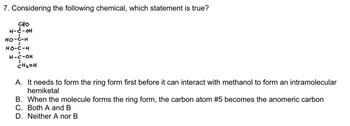
Chemistry
10th Edition
ISBN: 9781305957404
Author: Steven S. Zumdahl, Susan A. Zumdahl, Donald J. DeCoste
Publisher: Cengage Learning
expand_more
expand_more
format_list_bulleted
Question

Transcribed Image Text:### Question 7: Considering the following chemical, which statement is true?
**Diagram Explanation:**
The diagram depicts an open-chain form of a carbohydrate molecule, most likely a glucose molecule. It contains the following structure:
```
CHO
|
H - C - OH
|
HO - C - H
|
HO - C - H
|
H - C - OH
|
CH2OH
```
**Answer Choices:**
A. It needs to form the ring form first before it can interact with methanol to form an intramolecular hemiacetal.
B. When the molecule forms the ring form, the carbon atom #5 becomes the anomeric carbon.
C. Both A and B
D. Neither A nor B
**Detailed Explanation:**
The structure shown is an open-chain form of a monosaccharide. In aqueous solution, this monosaccharide can cyclize to form a ring structure through an intramolecular reaction where the hydroxyl group on one of the carbon atoms (typically the penultimate carbon, in this case, carbon atom #5) reacts with the aldehyde group (located on carbon atom #1). This results in the formation of a hemiacetal.
- **Statement A**: This is true. In the formation of a hemiacetal, the molecule usually has to convert to its cyclic form.
- **Statement B**: This is incorrect. When the ring forms, carbon atom #1 (the carbonyl carbon) becomes the anomeric carbon, not carbon atom #5.
**Correct Answer:**
D. Neither A nor B
This transcription and explanation provide an understanding of monosaccharide behavior in cyclization reactions, relevant to the given chemical structure.
Expert Solution
This question has been solved!
Explore an expertly crafted, step-by-step solution for a thorough understanding of key concepts.
Step by stepSolved in 3 steps with 1 images

Knowledge Booster
Learn more about
Need a deep-dive on the concept behind this application? Look no further. Learn more about this topic, chemistry and related others by exploring similar questions and additional content below.Similar questions
- identify the alkane that contains six carbons A.hexane B.hexyne C.hexanone D. hexenearrow_forwardMany functional groups are important in biochemical reactions. Name the functional group in the side chain of Aspartate: a. Carboxyl b. Amino c. amide d. methyl e. Sulfhydrylarrow_forward18. Which statement(s) is/are true regarding chiral carbons? A. All chiral carbons must have a tetrahedral geometry. B. All chiral carbons must be bonded to four different elements. C. Both A and B are true. D. Neither A nor B is true.arrow_forward
arrow_back_ios
arrow_forward_ios
Recommended textbooks for you
 ChemistryChemistryISBN:9781305957404Author:Steven S. Zumdahl, Susan A. Zumdahl, Donald J. DeCostePublisher:Cengage Learning
ChemistryChemistryISBN:9781305957404Author:Steven S. Zumdahl, Susan A. Zumdahl, Donald J. DeCostePublisher:Cengage Learning ChemistryChemistryISBN:9781259911156Author:Raymond Chang Dr., Jason Overby ProfessorPublisher:McGraw-Hill Education
ChemistryChemistryISBN:9781259911156Author:Raymond Chang Dr., Jason Overby ProfessorPublisher:McGraw-Hill Education Principles of Instrumental AnalysisChemistryISBN:9781305577213Author:Douglas A. Skoog, F. James Holler, Stanley R. CrouchPublisher:Cengage Learning
Principles of Instrumental AnalysisChemistryISBN:9781305577213Author:Douglas A. Skoog, F. James Holler, Stanley R. CrouchPublisher:Cengage Learning Organic ChemistryChemistryISBN:9780078021558Author:Janice Gorzynski Smith Dr.Publisher:McGraw-Hill Education
Organic ChemistryChemistryISBN:9780078021558Author:Janice Gorzynski Smith Dr.Publisher:McGraw-Hill Education Chemistry: Principles and ReactionsChemistryISBN:9781305079373Author:William L. Masterton, Cecile N. HurleyPublisher:Cengage Learning
Chemistry: Principles and ReactionsChemistryISBN:9781305079373Author:William L. Masterton, Cecile N. HurleyPublisher:Cengage Learning Elementary Principles of Chemical Processes, Bind...ChemistryISBN:9781118431221Author:Richard M. Felder, Ronald W. Rousseau, Lisa G. BullardPublisher:WILEY
Elementary Principles of Chemical Processes, Bind...ChemistryISBN:9781118431221Author:Richard M. Felder, Ronald W. Rousseau, Lisa G. BullardPublisher:WILEY

Chemistry
Chemistry
ISBN:9781305957404
Author:Steven S. Zumdahl, Susan A. Zumdahl, Donald J. DeCoste
Publisher:Cengage Learning

Chemistry
Chemistry
ISBN:9781259911156
Author:Raymond Chang Dr., Jason Overby Professor
Publisher:McGraw-Hill Education

Principles of Instrumental Analysis
Chemistry
ISBN:9781305577213
Author:Douglas A. Skoog, F. James Holler, Stanley R. Crouch
Publisher:Cengage Learning

Organic Chemistry
Chemistry
ISBN:9780078021558
Author:Janice Gorzynski Smith Dr.
Publisher:McGraw-Hill Education

Chemistry: Principles and Reactions
Chemistry
ISBN:9781305079373
Author:William L. Masterton, Cecile N. Hurley
Publisher:Cengage Learning

Elementary Principles of Chemical Processes, Bind...
Chemistry
ISBN:9781118431221
Author:Richard M. Felder, Ronald W. Rousseau, Lisa G. Bullard
Publisher:WILEY